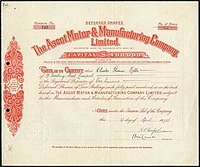Ascot-Pullin Motorcycles
 Share certificate issued on 4 April 1928 | |
| Company type | Limited |
|---|---|
| Industry | Motorcycle design and manufacturing |
| Founded | 1928 in Letchworth, UK |
| Founder | Cyril Pullin |
| Defunct | 1930 |
| Fate | Liquidation |
| Headquarters | Pixmore Avenue and Dunhams Lane, Letchworth SG6 , UK |
| Products | Motorcycles |
Production output | c. 400-500 motorcycles (1928-1930) |
| Brands | Ascot-Pullin |
| Owner | Cyril Pullin |
| Footnotes / references [1][2] | |
Ascot-Pullin Motorcycles was a British motorcycle manufacturer founded by Cyril Pullin as the Ascot Motor & Manufacturing Co Ltd. at Letchworth, Hertfordshire in 1928.[1] An inventor and winner of the 1914 Isle of Man TT, Pullin had been developing ideas for motorcycle designs since 1920 with Stanley Groom, and had patented a two-stroke engine motorcycle with pressed sheet metal frame and forks. After leaving Douglas[clarification needed] the first time, Pullin worked with Groom again to refine his ideas and develop and patent the Ascot-Pullin motorcycle.[3] Fewer than 500 were built and sales were poor, resulting in the company's liquidation in 1930.[4]
Ascot-Pullin 500
[edit]
Pullin was an innovator and the Ascot-Pullin 500 OHV single had the engine horizontally mounted and enclosed with a pressed-steel frame.[2] As well as the first use of hydraulic brakes on a motorcycle, Pullin also designed a telescopic centre stand and an adjustable windshield with a windscreen wiper and rear-view mirror, as well as a fully enclosed chain and interchangeable wheels.[5][2]
Powerwheel
[edit]The Ascot-Pullin name was revived in 1951 by the Hercules Cycle and Motor Company, a division of Tube Investments, who commissioned Pullin's new invention, the "Powerwheel", a 40 cc (2.4 cu in), 0.7 hp (0.52 kW), single-cylinder rotary engine. The prototypes were scrapped after the company decided not to proceed with production, but a sectionalised example survived together with most of the drawings, and an industrialised version was developed for the Ministry of Supply.[6]
Sources
[edit]- ^ a b "Ascot Motor and Manufacturing Co". GracesGuide.co.uk. Grace's Guide Ltd. Archived from the original on 28 March 2019. Retrieved 28 March 2019.
- ^ a b c "Ascot Pullin". GracesGuide.co.uk. Grace's Guide Ltd. Archived from the original on 28 March 2019. Retrieved 28 March 2019.
- ^ "Douglas Patents". Retrieved 30 November 2008.
- ^ "Ascot-Pullin". Archived from the original on 11 December 2008. Retrieved 30 November 2008.
- ^ Brown, Roland (1 September 1999). The History of British Bikes (hardback). Bath, United Kingdom: Parragon Plus. ISBN 978-0-752-53153-3. OCLC 42578944. OL 10821108M.
- ^ "Federation of British Historic Vehicle Clubs" (PDF). Newsletter. 2006. Archived from the original (PDF) on 6 July 2008. Retrieved 1 December 2008.
External links
[edit]- Ascot Motor and Manufacturing Co at Grace's Guide to British Industrial History
- Ascot Pullin at Grace's Guide
